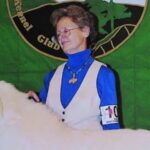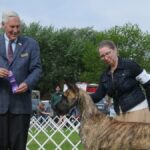Interview with Kelli Edell, Breeder of Kelwyn Scottish Terriers
Please tell us a little bit about yourself. Where do you live? What is your breed? What is your kennel name? Do you have a website? How long have you been in dogs? How long have you been breeding dogs? Who are some of your best-known dogs?
Kelli Edell: I live in Richmond, Texas, a suburb of Houston, and have been showing and breeding Kelwyn Scottish Terriers for 20-plus years. But, I have had Scottish Terriers for 55 years and there is absolutely no other breed on the planet I would rather have “own me.”
Some of my best-known dogs are: “Apolo” (Multi. RBIS & BISS GCHG Kelwyn’s History In The Making); “Kearney” (MBIS MBISS GCHS Kelwyn’s GM Freestyle Flyer CA); “Zena” (Top 5 Terrier, No. 1 Scottish Terrier Breed and All-Breed, Lloyd Award Winner MBIS MBISS GHCG Kelwyn’s Warrior Princess CA); “Grace” (MBIS MBISS GCHP Kelwyn’s High Society); and “Zeus” (CH Kelwyn’s Heavenly Thunderbolt CA). Zeus is best-known for his significant contribution to the breed as a pre-potent stud dog with amazing conformation.
As a Breeder, can you share your thoughts on your breed today? Is breed type strong? Are there things to be concerned about? Are there any health-related issues? Have you worked with breeders overseas? Are pet homes typically available for your breed?
Kelli Edell: As a preservation breeder, I believe that we should regularly see the best breeding stock exhibited and winning; however, I rarely see a dog with breed type exhibited and it is typically not winning. Scotties are supposed to be low-slung and have “digging fronts” and driving rears in order to perform their intended function. What wins today are high-on-leg, straight in the shoulders, square-ish dogs with nothing in front or behind that could never go-to-ground. This is not an anomaly—these incorrect dogs are setting winning records and new breeders run to breed with these dogs. The result is that our Breed Standard is effectively being changed, one judging assignment at a time.
The lack of quality stud dogs, and health issues, have led me to expand my search for quality stud dogs outside the US. I have found some like-minded breeders with beautiful, healthy dogs in Finland and Germany, and so, I frequently import semen or an occasional puppy for my breeding program. This is expensive, but I do not believe there is any hope of maintaining our Standard by breeding to “the dog next door.” I strive to stay true to type in every breeding decision and, as a result, many exhibitors and judges say that they can identify my dogs regardless of who is showing them. That is a type. What people need to understand is that to improve a “type” you must have one in the first place.
As an Exhibitor, can you comment on recent entries in your breed? Are majors available in your area? Does your breed often participate in Companion and Performance events? How can newcomers in your breed be encouraged to join the sport of dogs?
Kelli Edell: Entries in our breed are down overall and majors are hard to find. This is a barrier to entry for new people and it chases away longtime exhibitors who just can’t afford to travel great distances to find majors required to finish championships on their dogs. And frankly, many don’t believe that they can finish their dogs if they are close to the Breed Standard. Experienced exhibitors are becoming much more selective about judges for whom they will make entries.
On the positive side, I have noticed many more exhibitors trying Performance Events like Lure Coursing, Fast CAT, Scent Work, and Agility. These have much more allure, as the events are fun, exhibitors are friendly and helpful, and wins are based on merit, unlike in Conformation. For these reasons, I believe that these events will not only survive but will thrive.
What are the biggest challenges facing the dog show community as a whole and how can we address them? And finally, what are some of the positive changes you’ve seen in your breed and in the dog show community as a whole over the past decade?
Kelli Edell: It will take perseverance and hard work to address the issues plaguing the dog show community—there is no “silver bullet.” I think we need to start with Judges’ and Breeder Education. In our breed, we have an excellent judges’ education program; however, there is a lack of integrity in applying the Standard. We need to find a way to make judging as objective as possible. If judges apply the Standard, people will try to breed to it. It is imperative to develop a system to grade the judges objectively and publish those grades. Maybe significant shows could be judged by a panel of judges who must independently complete a written critique or scorecard for each dog. I always feel confident to enter the Top 20 even though the three judges are unknown to the exhibitors in advance because they have to complete a scorecard which is tallied.
What is winning? It is producing a beautiful, healthy dog with a sound temperament that is recognized for its contributions to the breed.








